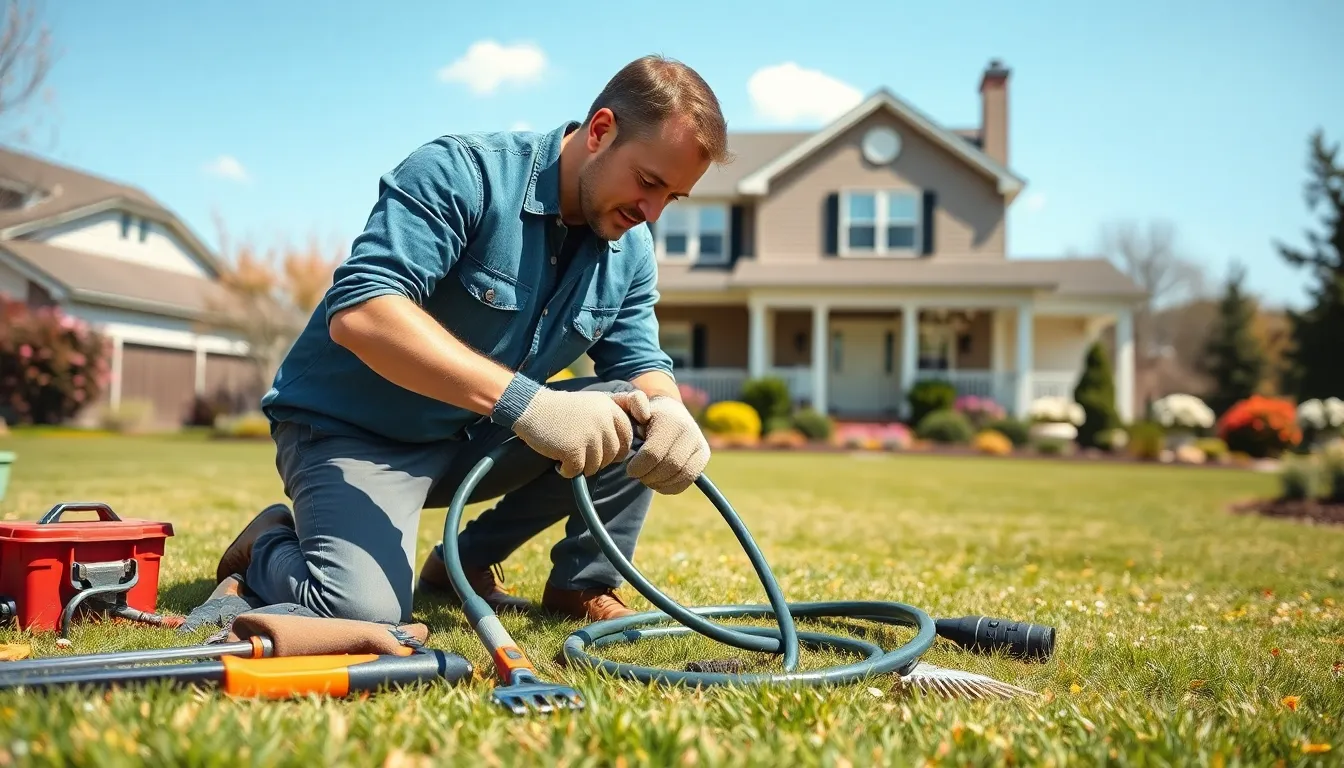Owning a home is like having a pet—if you don’t take care of it, things can get messy fast. A home maintenance checklist is your trusty sidekick in the battle against household chaos. It’s not just a list; it’s a superhero cape that helps homeowners swoop in and save the day before minor issues turn into major catastrophes.
Table of Contents
ToggleImportance Of A Home Maintenance Checklist
A home maintenance checklist serves as a vital resource for homeowners. Regularly reviewing this checklist prevents minor issues from becoming major concerns. Routine inspections of key areas like roofing and plumbing save money and time. Identifying problems early increases the chances of effective repairs.
Risk mitigation is another crucial benefit. Addressing maintenance tasks before they escalate reduces the likelihood of more severe damage. For instance, checking gutters and downspouts can prevent water damage to the home’s foundation. Preventive maintenance activities like changing air filters ensure systems operate efficiently.
Tracking maintenance work also aids in budgeting. Homeowners can anticipate costs associated with replacements or repairs. Creating a checklist allows for the scheduling of seasonal maintenance, leading to more informed financial planning. Using technology to set reminders for tasks can enhance accountability.
Enhancing home value is an additional factor. A well-maintained property attracts potential buyers and can command a higher selling price. Regular upkeep demonstrates responsibility, appealing to those within the real estate market.
A home maintenance checklist supports homeowners in several critical ways. It empowers proactive management, mitigates risks, assists in budgeting, and elevates property value. This tool ultimately contributes to the long-term health and comfort of the home environment.
Seasonal Maintenance Tasks

Seasonal maintenance keeps a home in optimal condition. Regular attention helps prevent major problems, ensuring comfort and safety.
Spring Checklist
Spring marks a great time to inspect the roof for damage after winter storms. Cleaning gutters encourages proper drainage and prevents water-related issues. He or she can also check for cracks in the foundation and seal them. Landscaping tasks include pruning shrubs to promote healthy growth. Testing air conditioning systems ensures they run efficiently for the warmer months ahead.
Summer Checklist
During summer, checking smoke detectors holds significant importance. Cleaning outdoor spaces, like patios and decks, enhances the home’s appeal. Inspecting the irrigation system helps manage water usage effectively. He or she should also clean or replace filters in HVAC units for optimal performance. Scheduling concrete or asphalt sealing prevents damage from heat and moisture.
Fall Checklist
Fall calls for a thorough examination of HVAC systems before the colder months. Cleaning gutters again prevents blockages due to falling leaves. Homeowners should check weather stripping on doors and windows to maintain energy efficiency. Inspecting the chimney ensures it is free of debris and ready for use. Installing storm windows or doors adds an extra layer of protection.
Winter Checklist
Winter emphasizes the importance of protecting pipes from freezing. He or she should check insulation in attics and basements for effectiveness. Cleaning the fireplace and checking for issues ensures safe use during colder evenings. Snow removal strategies become crucial to protect walkways and prevent damage to the property. Monitoring the heating system prevents breakdowns when they are needed most.
Monthly Maintenance Tasks
Monthly maintenance tasks help ensure a home remains in top shape. Regularly checking various systems prevents costly repairs and enhances comfort.
HVAC System Check
Inspecting the HVAC system each month keeps it running efficiently. He or she should change air filters to maintain good air quality. Cleaning the outdoor unit helps maximize cooling efficiency in warmer months. Additionally, checking the thermostat ensures accurate temperature regulation. Homeowners benefit from scheduling a professional inspection annually, catching any underlying issues before they become serious problems.
Plumbing Inspections
Plumbing inspections are crucial for identifying leaks before they damage property. Homeowners must examine pipes and fixtures for signs of wear or corrosion. Checking water pressure can indicate possible blockages or leaks. Regularly clearing faucet aerators and showerheads prevents mineral buildup. Lastly, inspecting toilets ensures they flush properly and do not waste water, ultimately preserving resources and reducing bills.
Annual Maintenance Tasks
Annual maintenance tasks play a critical role in preserving a home’s condition and ensuring safety. Homeowners should prioritize specific inspections and reviews to maintain their properties effectively.
Roof and Gutter Inspection
Inspecting roofs and gutters annually prevents costly water damage. Homeowners should look for missing shingles, rust, and debris. Cleaning gutters ensures proper drainage, safeguarding foundations from excessive moisture. It’s advisable to check for signs of leaks in the attic or ceiling. Addressing issues promptly minimizes further damage. Homeowners can schedule this inspection for early spring, aligning it with seasonal maintenance tasks.
Electrical System Review
Reviewing the electrical system annually promotes safety and efficiency. First, check for frayed wires and loose connections around outlets and switches. Breakers and fuses should function properly to prevent hazards. Testing smoke detectors ensures they operate effectively, enhancing overall safety. Additionally, it’s wise to assess the load on circuits to prevent overloads. Scheduling an inspection with a licensed electrician offers a thorough assessment and peace of mind. Regular maintenance of electrical systems mitigates risks and enhances home safety.
Tools And Resources For Home Maintenance
Home maintenance requires essential tools and resources for effective execution. A basic toolkit should include items like hammers, screwdrivers, pliers, and wrenches for common repairs. Safety equipment such as gloves, goggles, and masks ensures protection while performing tasks.
Online resources can aid in maintenance planning. Websites like the American Homeowners Association provide checklists, guides, and tips specific to various tasks. Mobile apps also help homeowners schedule maintenance and set reminders for inspections, ensuring consistency.
Local hardware stores offer materials and advice. Home improvement centers often provide demos and workshops, allowing homeowners to learn about tools and maintenance techniques. Additionally, rental services for specialized equipment, like pressure washers or drain snakes, reduce the cost of one-time projects.
Professional services, although more costly, enhance reliability for complex maintenance tasks. Seeking licensed plumbers or electricians for critical inspections guarantees safety and compliance with building codes. Annual maintenance contracts may lower costs, offering regular check-ups of HVAC systems or plumbing.
Community resources encourage collaboration and knowledge sharing. Neighborhood groups or online forums enable homeowners to exchange tips and recommend reliable contractors. Such engagement fosters a supportive environment, and a collective approach to maintenance can lead to discovered solutions.
Utilizing these tools and resources promotes proactive home maintenance. Regular inspections and timely repairs ensure a well-maintained home, leading to long-term benefits and improved safety. Homeowners gain peace of mind knowing they can tackle issues effectively.
A home maintenance checklist is more than just a list; it’s a vital tool that empowers homeowners to keep their properties in excellent condition. By proactively addressing issues and scheduling routine inspections, they can prevent small problems from turning into costly repairs. Each seasonal and monthly task plays a crucial role in maintaining safety and comfort throughout the year.
Utilizing the right tools and resources ensures that homeowners stay organized and informed, making the maintenance process more manageable. With a commitment to regular upkeep, homeowners not only protect their investment but also create a welcoming environment that enhances their quality of life. Embracing this proactive approach leads to a healthier home and greater peace of mind.




